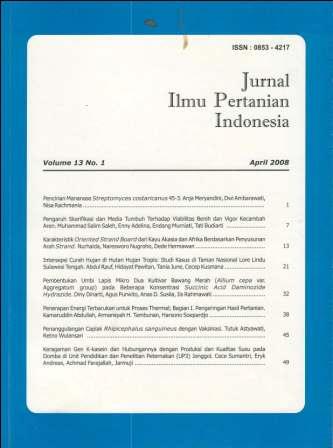Karakteristik Oriented Strand Board dari Kayu Akasia dan Afrika Berdasarkan Penyusunan Arah Strand
Abstract
The research objectives arc to evaluate physical and mechanical properties of OSB based on strands
orientation; and to evaluate physical and mechanical properties of OSB made from akasia wood (Acacia mangium Wild) and afrika wood (Maesopsis eminii Engl). Akasia and afrika wood are used for OSB strand material with phenol formaldehyde (PF) as adhesives and addition of paraffin. OSB made in this research is consist of three plies whereas are differed into eight (8) strand orientations. In the making process, hot press was carried out at 160OC and pressure 25kg.cm-2 for 15 minutes. Determination of OSB physical and mechanical properties is referred to JIS A 5908-2003. Result showed that strand orientations has no affect to OSB physical properties except for linicr swelling 24h, but it significantly influence all mechanical properties of OSB. Wood species have an effect on mechanical properties of OSB in the dry test, wet MOE lengthwise test and OSB physical properties, particularly to OSB density
and water absorbing capability at 2h and 24h. All of OSB physical properties arc meet JIS A 5908-2003 standard, but not all of the mechanical properties such as dry MOE lengthwise, dry MOE and MOR widthwise. The best physical and mechanical properties is presented by OSB made from akasia wood in strand orientation F, G, Band C whereas all parameters meet JIS A 5908-2003 standard. In comparation with strand orientation B that is frequent used in industry, strand orientation F and G arc proficient to raise the modulus elasticity value (MOE) and strength (MOR) as much as 167.81-231.65% and 89.73-109.87%, respectively; especially in widthwise board application. Furthermore, strand orientation F and G arc more flexible as structural components.
Keywords: oriented strand board, phenol formaldehyde, strand orientation
Downloads
This journal is published under the terms of the Creative Commons Attribution-NonCommercial 4.0 International License. Authors who publish with this journal agree to the following terms: Authors retain copyright and grant the journal right of first publication with the work simultaneously licensed under a Creative Commons Attribution-NonCommercial 4.0 International License. Attribution — You must give appropriate credit, provide a link to the license, and indicate if changes were made. You may do so in any reasonable manner, but not in any way that suggests the licensor endorses you or your use. NonCommercial — You may not use the material for commercial purposes.



















